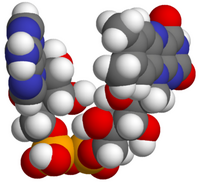
Photo from wikipedia
We have applied high-field (W-band) pulse electron-nuclear double resonance (ENDOR) and electron-electron double resonance (ELDOR)-detected nuclear magnetic resonance (EDNMR) to characterize the coordination sphere of the Mn2+ co-factor in the… Click to show full abstract
We have applied high-field (W-band) pulse electron-nuclear double resonance (ENDOR) and electron-electron double resonance (ELDOR)-detected nuclear magnetic resonance (EDNMR) to characterize the coordination sphere of the Mn2+ co-factor in the nucleotide binding sites (NBSs) of ABC transporters. MsbA and BmrCD are two efflux transporters hypothesized to represent divergent catalytic mechanisms. Our results reveal distinct coordination of Mn2+ to ATP and transporter residues in the consensus and degenerate NBSs of BmrCD. In contrast, the coordination of Mn2+ at the two NBSs of MsbA is similar, which provides a mechanistic rationale for its higher rate constant of ATP hydrolysis relative to BmrCD. Direct detection of vanadate ion, trapped in a high-energy post-hydrolysis intermediate, further supports the notion of asymmetric hydrolysis by the two NBSs of BmrCD. The integrated spectroscopic approach presented here, which link energy input to conformational dynamics, can be applied to a variety of systems powered by ATP turnover.
Journal Title: Structure
Year Published: 2017
Link to full text (if available)
Share on Social Media: Sign Up to like & get
recommendations!